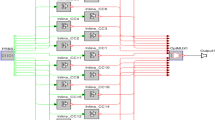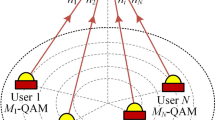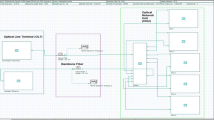Abstract
Non-orthogonal multiple access (NOMA) can be a desirable method since it can utilize resources efficiently to provide larger capacity. Similarly, optical transmission is also becoming popular due to the availability of licence-free large bandwidth and low-cost transceiver implementation. Although optical NOMA system can be promising for long range wireless systems, investigation of its reliability performance is essential for different channel models. In this study, outage probability, channel capacity, symbol error rate expressions, diversity and coding gains for arbitrary number of users are obtained for downlink-NOMA over free space optical links modeled with Málaga distribution. Theoretical results are verified by numerical examples for various scenarios providing useful background for future analyses and designs.









Similar content being viewed by others
Data Availability
No datasets were generated or analysed during the current study.
Notes
In what follows, index \( _j\) will be dropped for the sake of simplicity in derivations.
References
Wunder, G., Jung, P., Kasparick, M., Wild, T., Schaich, F., Chen, Y., Brink, S. T., Gaspar, I., Michailow, N., Festag, A., Mendes, L., Cassiau, N., Ktenas, D., Dryjanski, M., Pietrzyk, S., Eged, B., Vago, P., & Wiedmann, F. (2014). 5GNOW: Non-orthogonal, asynchronous waveforms for future mobile applications. IEEE Communications Magazine, 52(2), 97–105. https://doi.org/10.1109/MCOM.2014.6736749
Islam, S. M. R., Avazov, N., Dobre, O. A., & Kwak, K.-S. (2017). Power-domain non-orthogonal multiple access (NOMA) in 5G systems: Potentials and challenges. IEEE Communications Surveys & Tutorials, 19(2), 721–742. https://doi.org/10.1109/COMST.2016.2621116
Fernández Montefiore, M. C., González, G., Lopez-Martinez, F. J., & Gregorio, F. (2021). Effective capacity of finite-blocklength NOMA and OMA with heterogeneous latency requirements. In: 2021 Argentine Conference on Electronics (CAE), pp 78–81. https://doi.org/10.1109/CAE51562.2021.9397566.
Zhang, Y., & Kwan, D. (2017). Energy-efficient user scheduling and power allocation for noma wireless networks. The University of New South Wales.
Li, Z., Chen, W., Wu, Q., Wang, K., & Li, J. (2022). Joint beamforming design and power splitting optimization in IRS-assisted SWIPT NOMA networks. IEEE Transactions on Wireless Communications, 21(3), 2019–2033. https://doi.org/10.1109/TWC.2021.3108901
Ding, Z., Yang, Z., Fan, P., & Poor, H. V. (2014). On the performance of non-orthogonal multiple access in 5G systems with randomly deployed users. IEEE Signal Processing Letters, 21(12), 1501–1505. https://doi.org/10.1109/LSP.2014.2343971
Hou, T., Sun, X., & Song, Z. (2018). Outage performance for non-orthogonal multiple access with fixed power allocation over nakagami-\({m}\) fading channels. IEEE Communications Letters, 22(4), 744–747.
Agarwal, A., Chaurasiya, R., Rai, S., & Jagannatham, A. K. (2020). Outage probability analysis for NOMA downlink and uplink communication systems with generalized fading channels. IEEE Access, 8, 220461–220481. https://doi.org/10.1109/ACCESS.2020.3042993
Shaik, T., & Dhuli, R. (2022). Outage performance of multi cell-NOMA network over rician/rayleigh faded channels in interference limited scenario. AEU - International Journal of Electronics and Communications, 145, 154107. https://doi.org/10.1016/j.aeue.2022.154107
Bepari, D., Mondal, S., Pareek, P., & Gupta, N. (2024). Uplink performance analysis of wireless energy harvesting-enabled NOMA-based networks. Mobile Networks and Applications. https://doi.org/10.1007/s11036-024-02326-8
Wang, J., Liu, Y., Mu, X., Ma, X., Liu, W., & Xie, W. (2024). Joint subchannel and power allocation in NOMA-based spatial modulation systems. IEEE Transactions on Wireless Communications. https://doi.org/10.1109/TWC.2024.3387551
Nauryzbayev, G., Omarov, O., Arzykulov, S., Rabie, K. M., Li, X., & Eltawil, A. M. (2021). Performance limits of wireless powered cooperative NOMA over generalized fading. Transactions on Emerging Telecomunications Technologies, 33(4), 4415. https://doi.org/10.1002/ett.4415
Kara, F., & Kaya, H. (2018). BER performances of downlink and uplink NOMA in the presence of SIC errors over fading channels. IET Communications, 12(15), 1834–1844. https://doi.org/10.1049/iet-com.2018.5278
Lee, I., & Kim, J. (2019). Average symbol error rate analysis for non-orthogonal multiple access with \({M}\)-ary QAM signals in rayleigh fading channels. IEEE Communications Letters, 23(8), 1328–1331. https://doi.org/10.1109/LCOMM.2019.2921770
Yu, Y., Chen, H., Li, Y., Ding, Z., & Vucetic, B. (2018). On the performance of non-orthogonal multiple access in short-packet communications. IEEE Communications Letters, 22(3), 590–593. https://doi.org/10.1109/LCOMM.2017.2786252
Sashiganth, M., Thiruvengadam, S. J., & Kumar, D. S. (2020). BER analysis of full duplex NOMA downlink and uplink cooperative user relaying systems over Nakagami-\(m\) fading environment. Physical Communication, 38, 100963. https://doi.org/10.1016/j.phycom.2019.100963
Alqahtani, A., Alsusa, E., Al-Dweik, A., & Al-Jarrah, M. (2021). Performance analysis for downlink NOMA over \(\alpha \) - \(\mu \) generalized fading channels. IEEE Transactions on Vehicular Technology, 70(7), 6814–6825. https://doi.org/10.1109/TVT.2021.3082917
Alqahtani, A. S., & Alsusa, E. (2020). Performance analysis of downlink NOMA system over \(\alpha \) - \(\eta \) - \(\mu \) generalized fading channel. In: 2020 IEEE 91st Vehicular Technology Conference (VTC2020-Spring), pp 1–5
Thapliyal, S., Pandey, R., & Charan, C. (2022). NOMA-based UAV system under finite blocklength regime with analysis in Rician fading channel. Digital Signal Processing, 120, 103253. https://doi.org/10.1016/j.dsp.2021.103253
Aslan, K., & Gucluoglu, T. (2021). Performance analysis of downlink-noma over generalized-k fading channels. Physical Communication, 48, 101414. https://doi.org/10.1016/j.phycom.2021.101414
Aslan, K., & Gucluoglu, T. (2022). Performance analysis of NOMA uplink transmission over generalized-K fading channels. International Journal of Communication Systems, 35(6), 5063. https://doi.org/10.1002/dac.5063
Dixit, V., & Kumar, A. (2022). BER performance of MIMO based NOMA-VLC system with imperfect SIC. Transactions on Emerging Telecommunications Technologies, 33(4), 4422. https://doi.org/10.1002/ett.4422
Uday, T., Kumar, A., & Natarajan, L. (2022). Joint NOMA for improved SER of cell-edge users in multi-cell indoor VLC. IEEE Wireless Communications Letters, 11(1), 13–17. https://doi.org/10.1109/LWC.2021.3117923
Kaushal, H., & Kaddoum, G. (2017). Optical communication in space: Challenges and mitigation techniques. IEEE Communications Surveys Tutorials, 19(1), 57–96. https://doi.org/10.1109/COMST.2016.2603518
Khalighi, M. A., & Uysal, M. (2014). Survey on free space optical communication: A communication theory perspective. IEEE Communications Surveys & Tutorials, 16(4), 2231–2258. https://doi.org/10.1109/COMST.2014.2329501
Kannan, A., Hemanth, C., & Sangeetha, R. G. (2017). A review on channel models in free space optical communication systems. Optics & Laser Technology, 97, 161–171. https://doi.org/10.1016/j.optlastec.2017.06.018
Samimi, H. (2012). Distribution of the sum of k-distributed random variables and applications in free-space optical communications. Optoelectronics, IET, 6, 1–6. https://doi.org/10.1049/iet-opt.2010.0105
Popoola, W., & Ahmadi, V. (2008). Performance of sub-carrier modulated free-space optical communication link in negative exponential atmospheric turbulence environment. International Journal of Autonomous and Adaptive Communications Systems, 1, 342–355. https://doi.org/10.1504/IJAACS.2008.019809
Gupta, R., Kamal, T., & Singh, P. (2019). Concatenated LDPC-TCM codes for better performance of OFDM-FSO system using gamma-gamma fading model. Wireless Personal Communications, 106, 2247–2260. https://doi.org/10.1007/s11277-018-5939-3
Yu, S., Ding, J., Fu, Y., Ma, J., Tan, L., & Wang, L. (2019). Novel approximate and asymptotic expressions of the outage probability and BER in gamma-gamma fading FSO links with generalized pointing errors. Optics Communications, 435, 289–296. https://doi.org/10.1016/j.optcom.2018.11.021
El Saghir, B. M., El Mashade, M. B., & Aboshosha, A. M. (2021). Performance analysis of MRR FSO communication system under gamma-gamma turbulence channel with pointing error. Optics Communications, 489, 126891. https://doi.org/10.1016/j.optcom.2021.126891
Updhya, A. (2022). Investigation of mixed RF/FSO decode-and-forward NOMA cooperative relaying networks. Wireless Personal Communications, 124, 2923–2938. https://doi.org/10.1007/s11277-022-09496-2
Zhang, Z., Sun, Q., López-Benítez, M., Chen, X., & Zhang, J. (2022). Performance analysis of dual-hop RF/FSO relaying systems with imperfect CSI. IEEE Transactions on Vehicular Technology, 71(5), 4965–4976. https://doi.org/10.1109/TVT.2022.3149759
Jamali, M. V., & Mahdavifar, H. (2020). Uplink non-orthogonal multiple access over mixed RF-FSO systems. IEEE Transactions on Wireless Communications, 19(5), 3558–3574. https://doi.org/10.1109/TWC.2020.2974947
Ahmed, M. S., & Gucluoglu, T. (2021). Maximum ratio transmission based generalized frequency division multiplexing over gamma-gamma channel. Optics Communications, 492, 126965. https://doi.org/10.1016/j.optcom.2021.126965
Das, A., Bag, B., Bose, C., & Chandra, A. (2020). Free space optical links over málaga turbulence channels with transmit and receive diversity. Optics Communications, 456, 124591. https://doi.org/10.1016/j.optcom.2019.124591
Chen, D., Liu, Y., & Wang, M. (2021). Channel capacity and outage probability analysis for free space optical communication over composite channel. Optical Review, 28, 368–375. https://doi.org/10.1007/s10043-021-00669-1
Samimi, H. (2012). Optical communication using subcarrier intensity modulation through generalized turbulence channels. Journal of Optical Communications and Networking, 4(5), 378–381. https://doi.org/10.1364/JOCN.4.000378
Yousif, B. B., Elsayed, E. E., & Alzalabani, M. M. (2019). Atmospheric turbulence mitigation using spatial mode multiplexing and modified pulse position modulation in hybrid RF/FSO orbital-angular-momentum multiplexed based on mimo wireless communications system. Optics Communications, 436, 197–208. https://doi.org/10.1016/j.optcom.2018.12.034
Chen, D., Lu, M., & Wang, H. (2021). Performance of spatial diversity for FSO links with pointing errors over malaga turbulence. In: 2021 19th International Conference on Optical Communications and Networks (ICOCN), pp 1–3. https://doi.org/10.1109/ICOCN53177.2021.9563632
Alheadary, W. G., Park, K.-H., & Alouini, M.-S. (2016). Performance analysis of subcarrier intensity modulation using rectangular QAM over malaga turbulence channels with integer and non-integer \(\beta \). Wireless Communications and Mobile Computing, 16(16), 2730–2742. https://doi.org/10.1002/wcm.2721
Yousif, B. B., & Elsayed, E. E. (2019). Performance enhancement of an orbital-angular-momentum-multiplexed free-space optical link under atmospheric turbulence effects using spatial-mode multiplexing and hybrid diversity based on adaptive MIMO equalization. IEEE Access, 7, 84401–84412. https://doi.org/10.1109/ACCESS.2019.2924531
Li, Y.-T., Geng, T.-W., & Gao, S.-J. (2023). On the error performance and channel capacity of a uniquely decodable coded FSO system over malaga turbulence with pointing errors. Optical Express, 31(21), 34264–34279. https://doi.org/10.1364/OE.499764
Vishwakarma, N., & R, S. (2021). Performance analysis of hybrid FSO/RF communication over generalized fading models. Optics Communications, 487, 126796. https://doi.org/10.1016/j.optcom.2021.126796
Sun, Q., Hu, Q., Wu, Y., Chen, X., Zhang, J., & Lopez-Benıtez, M. (2024). Performance analysis of mixed FSO/RF system for satellite-terrestrial relay network. IEEE Transactions on Vehicular Technology. https://doi.org/10.1109/TVT.2024.3373653
Girdher, A., Bansal, A., & Dubey, A. (2024). Energy efficient NOMA for mixed FSO-RF communication system with IRS-aided SLIPT. IEEE Transactions on Vehicular Technology. https://doi.org/10.1109/TVT.2024.3384079
Gradshteyn, I. S., & Ryzhik, I. M. (2007). Table of Integrals, Series, and Products (7th ed., p. 1171). Amsterdam: Elsevier/Academic Press.
Mahmood, A., Khan, S., Hussain, S., & Zeeshan, M. (2021). Performance analysis of multi-user downlink PD-NOMA under SUI fading channel models. IEEE Access, 9, 52851–52859. https://doi.org/10.1109/ACCESS.2021.3070147
Zhao, N., Li, D., Liu, M., Cao, Y., Chen, Y., Ding, Z., & Wang, X. (2019). Secure transmission via joint precoding optimization for downlink MISO NOMA. IEEE Transactions on Vehicular Technology, 68(8), 7603–7615. https://doi.org/10.1109/TVT.2019.2920144
Almohamad, A., Hasna, M. O., Althunibat, S., & Qaraqe, K. (2021). A novel downlink IM-NOMA scheme. IEEE Open Journal of the Communications Society, 2, 235–244. https://doi.org/10.1109/OJCOMS.2021.3051082
Nguyen, T. V., Pham, T. V., Dang, N. T., & Pham, A. T. (2020). Performance of generalized QAM/FSO systems with pointing misalignment and phase error over atmospheric turbulence channels. IEEE Access, 8, 203631–203644. https://doi.org/10.1109/ACCESS.2020.3036643
Yahya, H., Alsusa, E., & Al-Dweik, A. (2021). Exact ber analysis of noma with arbitrary number of users and modulation orders. IEEE Transactions on Communications, 69(9), 6330–6344. https://doi.org/10.1109/TCOMM.2021.3088526
Jurado-Navas, A., Garrido-Balsells, J., Paris, J. F., & Puerta-Notario, A. (2011). A unifying statistical model for atmospheric optical scintillation. Numerical simulations of physical and engineering processes, 181, 181–205.
Zheng, J., Zhang, Q., & Qin, J. (2019). Average block error rate of downlink noma short-packet communication systems in Nakagami- \(m\) fading channels. IEEE Communications Letters, 23(10), 1712–1716. https://doi.org/10.1109/LCOMM.2019.2930999
Mathai, A. M., & Saxena, R. K. (1973). Generalized hypergeometric functions with applications in statistics and physical sciences. Lecture Notes in Mathematics, vol. 348.
Indefinite integral of Meijer-G function. Retrieved 22 Oct 2023, from https://functions.wolfram.com/HypergeometricFunctions/MeijerG/21/01/01/
Wang, Z., & Giannakis, G. B. (2003). A simple and general parameterization quantifying performance in fading channels. IEEE Transactions on Communications, 51(8), 1389–1398. https://doi.org/10.1109/TCOMM.2003.815053
Lozano, A., Tulino, A. M., & Verdu, S. (2005). High-SNR power offset in multiantenna communication. IEEE Transactions on Information Theory, 51(12), 4134–4151. https://doi.org/10.1109/TIT.2005.858937
Badarneh, O., & Aloqlah, M. (2015). Performance analysis of digital communication systems over generalized \(\alpha -\eta -\mu \) fading channels. IEEE Transactions on Vehicular Technology, 65, 1–1. https://doi.org/10.1109/TVT.2015.2504381
Concus, P., Cassatt, D., Jaehnig, G., & Melby, E. (1963). Tables for the evaluation of \(\int _{x=0}^{\infty }x^{\beta }e^{-x}f(x)dx\) by gauss-laguerre quadrature. Mathematics of Computation, 17(83), 245–256.
Ansari, I. S., Yilmaz, F., & Alouini, M.-S. (2016). Performance analysis of free-space optical links over málaga (\(\cal{M} \)) turbulence channels with pointing errors. IEEE Transactions on Wireless Communications, 15(1), 91–102.
Acknowledgements
This work was supported by Research Fund of the Yildiz Technical University. Project Number: 5132
Funding
Supported by Research Fund of the Yildiz Technical University. Project Number: 5132
Author information
Authors and Affiliations
Corresponding author
Ethics declarations
Conflict of interest
The authors declare no competing interests.
Additional information
Publisher's Note
Springer Nature remains neutral with regard to jurisdictional claims in published maps and institutional affiliations.
Appendices
Appendix A: Derivation of PDF of SINR
Three steps to obtain the PDF of \(\gamma \) in (7) contain the derivations of PDFs for \(\frac{\delta }{\lambda }\), \(\frac{\delta }{\lambda }+\varrho \) and \(\frac{\kappa }{\frac{\delta }{\lambda }+\varrho }\). In the first stage, it is required that PDF of \(\frac{\delta }{\lambda }\) must be evaluated by using the PDF of \(\lambda \) (i.e. channel gain=\(I^2\)) which can be easily obtained as below,
where \(\zeta =\frac{\alpha \beta }{\eta \beta +\Omega '}\). The PDF of \(\tau =\frac{\delta }{\lambda }\) can be found via CDF of \(\lambda \) in (A1). The CDF of \(\tau \) is \(F_{\tau }(\tau )=1-Pr(0\le \lambda \le \frac{\delta }{\tau })\), then
When derivatives of both sides in (A2) are computed, one can get \(f_{\tau }(\tau )=\frac{\delta }{\tau ^2}f_{\lambda }(\frac{\delta }{\tau })\). By substituting \(\frac{\delta }{\tau }\) into (A1), \(f_{\tau }(\tau )\) is found as,
(6) can be rewritten as \(\gamma =\frac{\kappa }{\tau +\varrho }\). Considering \(\psi =\tau +\varrho \) and by using the CDF such that \(F_{\psi }(\psi )=Pr(\tau +\varrho \le \psi )\hspace{2pt}\Longrightarrow \hspace{2pt}F_{\psi }(\psi ) =Pr(0\le \tau \le \psi -\varrho )=F_{\tau }(\psi -\varrho )\). It is evident that after derivative of \(F_{\tau }(\psi -\varrho )\) is evaluated, \(f_{\psi }(\psi )\) can be found as,
(6) becomes \(\gamma =\frac{\kappa }{\psi }\). PDF of \(\gamma \) can be obtained from \(F_{\gamma }(\gamma )=Pr(\frac{\kappa }{\psi }\le \gamma )\hspace{2pt}\Longrightarrow \hspace{2pt} F_{\gamma }(\gamma )=1-Pr(\varrho \le \psi \le \frac{\kappa }{\gamma })\) as follows,
Boundary values of \(\gamma \) are computed as \(0\le \gamma \le \frac{\kappa }{\varrho }\). When (A5) is rearranged, (7) can be obtained.
Appendix B: PDF Parameters of Normalized SINR
In this section, derivations of the PDF of normalized SINR and the parameters a and t [57] (needed for diversity and coding gains) are presented. The term \((\sqrt{\sqrt{\chi }})^{\alpha +k-4}K_{\alpha -k}\bigg (2\sqrt{\zeta \sqrt{\chi }}\bigg )\) in (15) is multiplied with \(\frac{(2\sqrt{\zeta })^{\alpha +k-4}}{(2\sqrt{\zeta })^{\alpha +k-4}}\) in order to write it in terms of Meijer’s G-function [55, Section 2.6]. Then, it can be rewritten as,
When (B6) is substituted into (15), it can be written as,
Meijer’s G-function in (B7) can be written as follows ( [55, Theorem 1.4.3, Eq. (1.4.14)]) where z, q, p, \(a_p\) and \(b_q\) correspond to \(\zeta \sqrt{\chi }\), 2, 0, \((-,\hspace{10pt}{-})\) and \(({\alpha -2,\hspace{10pt} k-2})\), respectively.
When \(p=0\) and \(q=2\) are substituted into Eqs. (B8) and (B9), they become \(G_{0,2}^{2,0}(z|^{a_p}_{b_q})\sim [e^{-2\sqrt{z}}]z^{\rho ^{*}}\bigg [\pi ^{\frac{1}{2}} +\frac{M_1}{z^{\frac{1}{2}}}+\frac{M_2}{z^{\frac{1}{2}}}+...\bigg ]\) and \(\rho ^{*}=\frac{1}{2}[\alpha +k-\frac{9}{2}]\). The term \(e^{-2\sqrt{z}}\) can be expanded Maclaurin series as below,
The result obtained by substituting (B11) into (B7) can matches with (16) as below,
where
and
which eventually offers to obtain \(t=\frac{1}{4}[\alpha +k-\frac{9}{2}]\), \(a=\frac{A\pi ^{\frac{1}{2}}}{4\zeta ^{\frac{1}{4}}}a_k\) for only part of the summation in (B14).
Appendix C: Proof of Derivation of Average Channel Capacity
Derivation of the integral in (24) starts with the change of variables as \(x=\frac{\delta \gamma }{\kappa -\gamma \varrho }\), \(dx=\frac{\delta \kappa }{(\kappa -\gamma \varrho )^2}d_{\gamma }\) in that integral. Then, new parameters are substituted in (24) and it becomes as below by making some simple mathematical manipulations,
The term \(\bigg (2\sqrt{\zeta \sqrt{x}}\bigg )^{\alpha +k-4}K_{\alpha -k}\bigg (2\sqrt{\zeta \sqrt{x}}\bigg )\) in (C15) can be expressed in terms of Meijer’s G-function [55, Section 2.6] and thus AVC becomes,
Using the partial integration by changing variables as \(u=ln\bigg (\frac{x(\varrho +\kappa )+\delta }{x\varrho +\delta }\bigg )\) and \(dv=G_{0,2}^{2,0}\bigg (\zeta \sqrt{x}\bigg | _{\alpha -2,\;\;k-2}\bigg )dx\) with \(du=\bigg (\frac{1}{x+\frac{\delta }{\kappa +\varrho }}-\frac{1}{x+\frac{\delta }{\varrho }}\bigg )dx\), \(v=G_{1,3}^{2,1}\bigg [\zeta \sqrt{x}\bigg |^{1,\;\; }_{\alpha -1,\;\;k-1,\;\;0\;\;}\bigg ]\) obtained based on [56], one can obtain the following equation,
where \([uv]_{x=0}^{\infty }=ln\bigg (1+\frac{\kappa }{\varrho }\bigg )G_{1,3}^{2,1} \bigg [\infty \bigg |^{1,\;\; }_{\alpha -1,\;\;k-1,\;\;0\;\;}\bigg ]\) and the term \(G_{1,3}^{2,1}\bigg [\infty \bigg |^{1,\;\; }_{\alpha -1,\;\;k-1,\;\;0\;\;}\bigg ]\) converges to zero when variable x goes to infinity. Therefore, \([uv]_{x=0}^{\infty }=ln\bigg (1+\frac{\kappa }{\varrho }\bigg )G_{1,3}^{2,1}\bigg [\infty \bigg |^{1,\;\; }_{\alpha -1,\;\;k-1,\;\;0\;\;}\bigg ]=0\). Another change of variables in (C17) as \(\beta _{1}=\frac{\delta }{\kappa +\varrho }\), \(\beta _{2}=\frac{\delta }{\varrho }\) can be helpful in simplification as follows,
Integral in [55, Eq. 3.3.5a] is as follows,
where \(c^*=m+n-\frac{p}{2}-\frac{q}{2}\) and \(U=\displaystyle \sum _{j=1}^{q}b_j-\displaystyle \sum _{j=1}^{p}a_j+\frac{p}{2}-\frac{q}{2}+1\). \(\Delta (n,y)\) represents the set of n parameters [55, Page 70] \(\frac{y}{n}, \frac{y+1}{n},...,\frac{y+n-1}{n}\). When \(\sigma , \psi , s, r\) in [55, Eq. 3.3.5a] are selected as \(\sigma =1\), \(\psi =0\), \(s=1\), \(r=2\); then the both of integrals in (C18) can be put into form of integral in (C19).
When integral \(\int _{x=0}^{\infty }\frac{1}{x+\beta _{1}}G_{1,3}^{2,1}\bigg [\zeta \sqrt{x}\bigg |^{1,\;\; }_{\alpha -1,\;\;k-1,\;\;0\;\;}\bigg ]dx\) and integral [55, Eq. 3.3.5a] are compared, \(\sigma =1\), \(\omega =\beta _1\), \(\psi =0\), \(m=2\), \(n=1\), \(p=1\), \(\zeta =\zeta \), \(s=1\), \(r=2\), \(a_p=\{1\}\), \(b_q=\{\alpha -1, k-1, 0\}\). Based on this, \(c^*=1\), \(U=\alpha +k-3\), \(\Delta (r,a_p)=\Delta (2,\{1\})\) and \(\Delta (r,b_q)=\Delta (2,\{\alpha -1,k-1,0\})\).
Identity for \(\Delta (.)\) is given as \(\Delta (r,\{y_1, y_2,...,y_n\})\overset{\Delta }{=}\Delta (r,y_1), \Delta (r,y_2),...,\Delta (r,y_n)\) in [55, Page 117]. Based on that identity, \(\Delta (2,\{\alpha -1,k-1,0\})=\Delta (2,\alpha -1),\Delta (2,k-1),\Delta (2,0)\). Finally, expanded forms of \(\Delta (.)\)’s are written as \(\Delta (1,\{0\})=\{0\}\), \(\Delta (2,\{1\})=\{\frac{1}{2}, 1\} \), \(\Delta (2,\alpha -1)=\{\frac{\alpha -1}{2}, \frac{\alpha }{2}\}\), \(\Delta (2,k-1)=\{\frac{k-1}{2}, \frac{k}{2}\}\), \(\Delta (2,0)=\{0, \frac{1}{2}\}\). It is known that \(\Gamma (1)=1\). When all parameters and \(\Delta (.)\)’s are substituted into (C19), one of integrals can be rewritten as,
Result in (C20) is also valid for integral including \(\beta _2\) in (C18). Because, only different between integrals in (C18) is \(\beta _1\) and \(\beta _2\). Finally, when (C20) (i.e. \(\int _{x=0}^{\infty }vdu\)) is substituted into (C17), it can be rewritten as follows,
Rights and permissions
Springer Nature or its licensor (e.g. a society or other partner) holds exclusive rights to this article under a publishing agreement with the author(s) or other rightsholder(s); author self-archiving of the accepted manuscript version of this article is solely governed by the terms of such publishing agreement and applicable law.
About this article
Cite this article
Aslan, K., Gucluoglu, T. Performance Analysis of Downlink-NOMA Over Málaga Distributed Optical Links. Wireless Pers Commun 138, 1247–1271 (2024). https://doi.org/10.1007/s11277-024-11555-9
Accepted:
Published:
Issue Date:
DOI: https://doi.org/10.1007/s11277-024-11555-9




